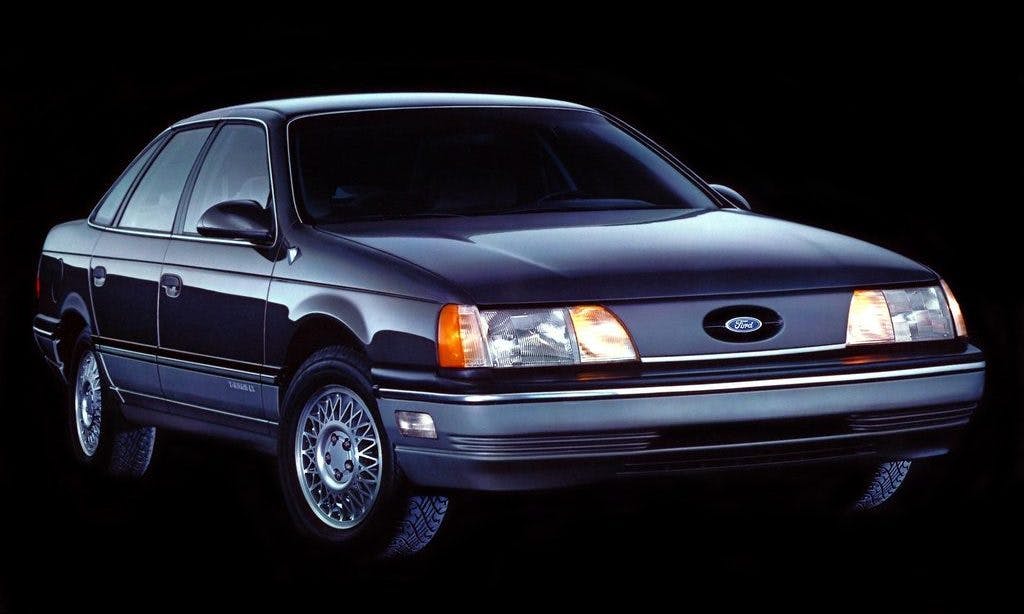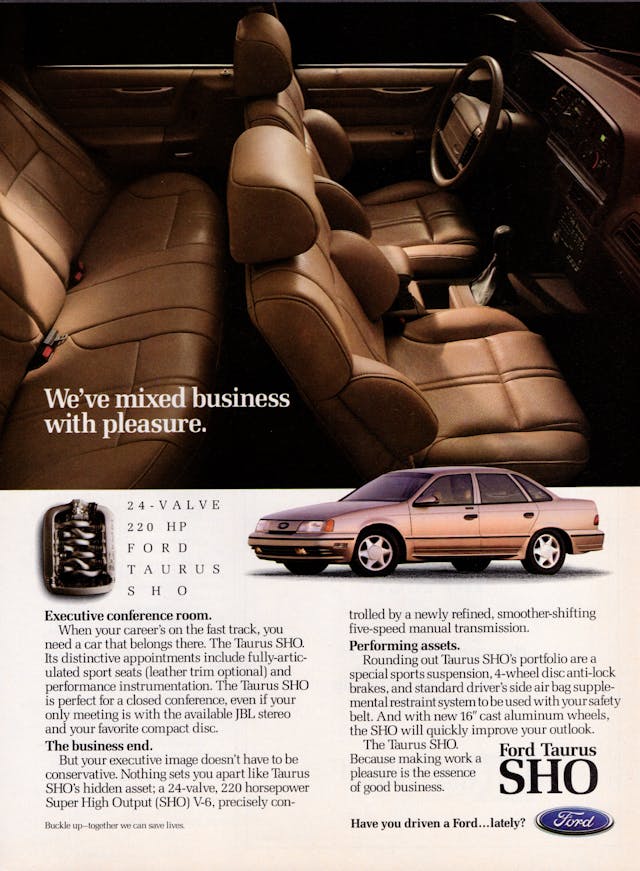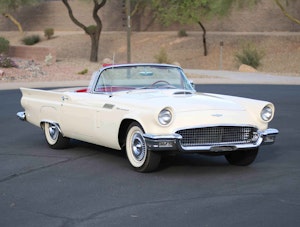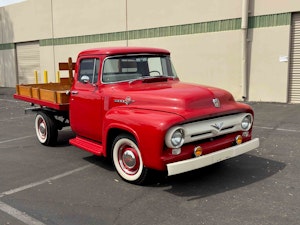Media | Articles
The 1989–91 Taurus SHO Still Punches Above Its Weight
The business theories of W. Edwards Deming, especially the notion of total quality management, aren’t something we enthusiasts consider when discussing the Ford Taurus. But the pre-Taurean Ford Motor Company definitely stood up and took notice, after Deming’s teachings made Japan Inc. a force to be reckoned with. His Fourteen Points could be considered the foundation, and the ubiquitous 1986 Ford Taurus is the mansion atop this new bedrock. That’s especially true of Deming’s ninth point:
“Break down barriers between departments. People in research, design, sales, and production must work as a team, to foresee problems of production and in use that may be encountered with the product or service.”


This happened with Ford’s Taurus, to the point that Team Taurus became a phrase used inside and outside the company. In Eric Taub’s book Taurus: The Making Of The Car That Saved Ford, it was noted that Ford engineers worked with designers in remarkable ways. One such example is when an engineer told VP of Design Jack Telnack that the Taurus’ front end design wouldn’t work for the cooling system. Telnack remarked, “Fine, then we will redesign the front to work for you.”
Apparently Telnack’s response shocked the engineer, as designers generally force their work upon engineering departments. But teamwork truly made a superior vehicle. That’s where Ronald Glantz, a partner Montgomery Securities, was quoted by the Chicago Tribune as saying the Taurus “looks like the car was designed by one person.”
Luckily for us enthusiasts, that “one person” wasn’t some plain jane suit interested in hard numbers. And by 1989, they had a penchant for making a segment-busting, sports-car dominating, SHO-stopping performance from a family sedan template.

Enter the 1989 Ford Taurus SHO (Super High Output), a vehicle with plenty of digital ink spilled across the internet in its name. We wrote about it here and here, and Jason Cammisa’s in-depth coverage leaves little else to say.
Marketplace
Buy and sell classics with confidence
And with all this acclaim, a few salient points remain: The SHO was quicker than anything this side of a BMW M5, handled with Germanic flair, and sported a base price just under $20,000. No vehicle is perfect, and the SHO was subtle in a sea of already radically designed Taurus sedans. But this couldn’t stop the SHO from winning near-universal praise, doing everything from securing a spot on Car and Driver Magazine’s 10 Best List, to earning a cult-like following.



And yet, somewhat tragically, the magic of the original Taurus SHO was slowly watered down over time. This isn’t referring to the later addition (1993) of an automatic transmission, as Ford was clever enough to increase displacement of that iconic Yamaha-designed engine from 3.0 to 3.2 liters to compensate for the torque-converted gearbox. Instead, consider how the first-generation SHO (1989-91) translated into a second generation, where performance was dulled to the point it can be tracked by the shrinking anti-roll bar diameters and the increasing levels of understeer they bestowed upon the Super High Output Taurus.
With the revolutionary good looks and impressive suspension prowess, the first-generation Taurus SHO has been appreciating at a rate on par with the broad crescendo of its Yamaha motor revving to its 7,300 rpm redline. Ten years ago, a SHO in #2 condition was a mere $4,700, and only $3,000 for an example in #3 condition. But today those same examples fetch $12,000 and $8,100, respectively.
A 155 percent appreciation rate is no small feat, especially for anything that looks like a family sedan from the 1980s. And the SHO has near-universal appeal, as Millennials quote 34 percent of SHO policies for Hagerty, while comprising 23 percent of the market. That outsize interest from younger enthusiasts suggests a strong near-term outlook for the SHO. Boomers comprise 32% of quotes sought, while Gen X comes in at 21 percent and Gen Y follows at 10 percent—all a little low relative to their percentage shares of the market, but still healthy. All told, there might be enough generational consensus to suggest the Taurus SHO is the United Nations of classic cars!


But the SHO’s appeal is also on par with vehicles that cost far more, with far more prestigious nameplates attached to them. While Hagerty Valuation data is sparse for this class of vehicle, a Mercedes-Benz 300E (W124) was $5,000 (#2 condition) and $3,700 (#3) back in 2014. That’s in line with the first generation SHO, but today the 300E is $14,600 and $8,200. While #3 condition examples of both are similar, even the $2600 difference between #2 examples is a testament to “Team Taurus” and what they created here in America.



We pulled Hagerty’s average insured values of both the Saab 900 Turbo and the BMW 535i (E34) for more context. Compared to a Taurus SHO in #2 condition, the Saab is over $1,000 cheaper ($10,818) while the BMW is insured for over $2,000 more ($14,364). Indeed, there are signs suggesting the Taurus SHO is still punching above its family sedan weight, going deep into European performance sedan territory.
This data sheds new light on a passage from Taurus: The Making Of The Car That Saved Ford, when Ford’s consumer advocate Joel Pitcoff discussed how chatter on the upcoming Taurus was heavily skewed to imported competition like the examples chosen here. While the base Taurus was supposed to be a mundane sedan worthy of Chevrolet Celebrity references, Pitcoff recalls the world didn’t see “a step up from a Celebrity.” Instead they saw “the near equivalent of a $25,000 import car that you could buy for $15,000.”
So with over 30 years of hindsight available, perhaps it comes as no surprise that a $20,000 Taurus SHO destroys everything even remotely close to that price point. It’s certainly not a bold statement to suggest that teamwork made dreams come true for a humble American family sedan. This is one moonshot design that paid off, be it for a mid-level Taurus GL in 1986, or in the year 2024 for the first-generation Taurus SHO.























Thank you for this excellent article on the SHO and Taurus. My wife & I have owned seven Taurus/Sables and have put well over 700,000 miles on them. All of them have given dependable service. For the past 12 years, I have owned a 1992 Taurus LX and it has been a great car that has required very little repair to keep running. I also own a W124 Mercedes coupe that was mentioned as a comparison to the Ford. In many ways, the Taurus has proven superior. The Ford’s rack & pinion steering is far more responsive that the rotating ball system in the Benz. The Ford’s overdrive transmission allows the Taurus to cruise at highway speeds with lower RPM than the Benz, even if the W124 has a higher top speed. Car guru Doug DeMuro reviewed the SHO and criticized the plastic interior but the interior plastic in my Mercedes has deteriorated much more than in the Ford.
I have never owned an SHO because I don’t want to change a timing belt in a transverse overhead cam V6, but I’m delighted that these cars are beginning to get the respect they deserve. Some people have criticized the Taurus for having poor quality, but the key to longevity and high miles in a Taurus or Sable is good service. The Taurus/Sables were very easy cars to service and repair, while offering many of the creature comforts of modern cars.
These are really nice cars, but good luck restoring one. As always, but the BEST one you can afford.
I owned a 92 from new, stick of course. Only car I’ve ever driven past 100,000 miles. The engine gained RPMs so fast you had to be thinking about the shift to second well before you launched.
I was an Engineering Mgr @ one of Ford’s NA assembly plants when the 1989 Taurus SHO was released. We were entitled to leasing any current model products Ford, L-M, or foreign manufacturer’s Ford owned & offered each year. I leased the Ford Taurus SHO that year. I was only manager that leased one.
What a great performance sedan it was with the Yamaha SHO V6 “bundle of snakes” multi-valve intake manifold, manual transmission, & mild mannered, no frills looks.
All the managers at the plant wanted to trade lease cars on WEs with me to “wring it out”. Try it out they did………the clutch barely lasted two months and I waited for replacement for weeks since the vehicle was so new.
The wife ended up with a speeding ticket getting off an interstate exit ramp one day due to her excessive speed getting around a slow going vehicle in the SHO.
My boss borrowed it one WE & headed up to the Detroit area. I needed to reach him on Sunday night & called the phone number he left me with. His brother answered the phone and said he had already left the area & was on his way back to Ohio. He said he would be back really soon since he was driving a “rocket ship”.
I thought its inaugural year of introduction was its best year.
I had an !986 SHO for my young family.. My wife got her first tast of sleeper car that with a 5 speed manual was an awesome drive. I get it was never intended to be a RWD but after seeing Jay Leno take a 1966 Riviara and flipping to RWD, I suspect the SHO would be just that much better than a RWD configuration.
I worked as an Engr Mgr for Ford in one of their NA assembly plants. One if the Mgmt Role benefits was picking a Mgmt Lease Evaluation vehicle each year.
I chose a 1989 Ford Taurus SHO the year they were introduced. It was an extremely fast vehicle w/ a manual transmission connected to the V6 Yamaha 24v engine with the “bundle of snakes” intake manifold.
I was the only management role guy in the plant with a SHO. Many of the other managers wanted to swap lease vehicles on WEs with me so they could “wring out” the SHO. After a couple months of this “WE abuse” the clutch finally failed & it had to be replaced. Since it was such a new model it took a few weeks to get the clutch replaced.
My wife ended up with a speeding ticket getting off the interstate after passing a slow poke on the road with it. She loved to power shift it!
My boss drove it to see his brother in the Detroit area one WE. I had to contact him late Dinday night & tried to reach him through his brother’s phone. His brother said he had left for Ohio earlier and would be there shortly. He was driving a “rocket ship” back…..my SHO!
Great memories. An awesome “sleeper” vehicle. Boy could looks deceive you.
I put over 230,000 miles on my 89 SHO and it still purred when I sold it.
Owned an ‘89 and a ‘96. The ‘89 was just raw power relative to other contemporary cars. Damn they were fun!
How many #2 SHOs are around for 12 grand? I would buy it instantly in that condition at that price. The few available are all beaters, at best number 3 condition (if that) and are priced considerably over 12 grand.
You guys do know that Millennials and Gen Y are the same thing, right? Perhaps you meant to say Gen Z instead of Y.
I own 7 SHOs of various years. Getting parts isn’t an issue anymore as there are aftermarket sellers (SHO enthusiasts) have filled the void.
The cars are not exceptionally great in any one thing. However, if you have driven one you probably remember the grin, getting out of the car and going wow that was fun! It’s a car you really feel connected to rowing through the gears. The harder you push the more the Yamaha motor is happy. It practically is begging for you to right foot down more. Bouncing off the rev limiter is mandatory.
Handing is predictable and the car is nicely balanced.
Time for me to go make one scream at 7k rpms.